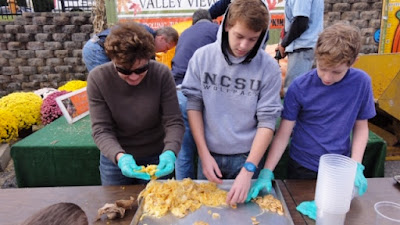 |
| Soft needled cedar |
 |
| Wreath-making in progress |
Many moons ago, I attended a Christmas Eve service at Calvary Baptist Church in Towson with my in-laws. The preceding week, my father-in-law' Max' had assisted in the church decorating, harvesting many of the evergreens used at the ends of church aisles from his yard. Years later, when given the chance to plant trees at my new home, thoughts of Max and his wife Elouise's yard gave me inspiration.
My yard is relatively small and bordered on the north side by tall, graceful hemlocks.
 |
| Canadian Hemlocks |
Their dark green needles and tiny cones were fun to use in decorating. Years before, a cryptomeria grew in the backyard of my previous home, so that was first on my list as I loved the ends of these gently weeping branches for wreaths and greens decorations.
.JPG) |
| Cryptomeria in my backyard has grown much larger since this photo was taken |
Holly made the list as well; an evergreen that berried year after year. The deciduous holly, winterberry, was also added.
 |
| Longwood uses winterberry in its Christmas displays too. |
For both of these, a male version was needed to propagate for berries. The front of the house, already in deep shade, was planted with Osmanthus, a natural addition for decorations.
 |
| Osmanthus Goshiki stays compact, loves the shade, and is deer resistant |
A few other trees were added along the opposite side of the yard from the hemlocks. Weeping Norway Spruce, a second Cryptomeria, Arizona cypress, Deodar cedar, and a non-evergreen Larch completed the side.
 |
| I love the size and texture of this Deodar Cedar |
To say that it was overplanted is an understatement.
Here's the best part; friends and family gather every December and make wreaths and greens for holiday decorating. Most of the greens are growing right in the backyard, and my guests bring things from their own gardens to add. Jan brings juniper and huge pine branches, Mary donates holly, and the rest of what we need is available in our greens area at Valley View Farms, which always reminds me to plant a dwarf southern magnolia next year. Billy had a row of pines along his large property and gifted us bags of pinecones. We have a great time and mentor one another on the best way to make and display our creations.
 |
| The Fern sisters (my family) enjoyed our wreath-making |
 |
| A great project for work friends too! |
This spring, when deciding what to plant in your yard, think of some of these trees and shrubs to add to your landscape. Make decorations from nature for your next holiday season.
Merry Christmas and Happy Holidays to all.
For more information about trees and shrubs for your landscape, visit our website at Valley View Farms and click on the Plant Finder tab.













.jpg)

















.JPG)













